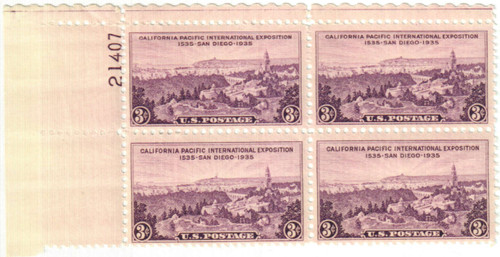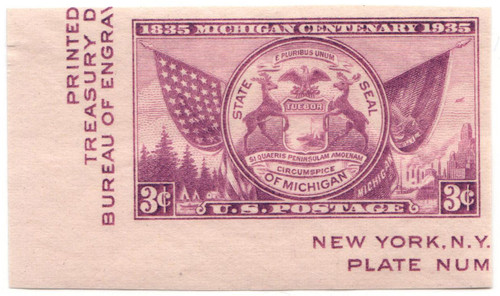
1936 3c California Pacific International Exposition, imperf single
# 778b - 1936 3c California Pacific International Exposition, imperf single
$0.70 - $1.00
U.S. #778
1936 Third International Philatelic Exposition
Souvenir Sheet
1936 Third International Philatelic Exposition
Souvenir Sheet
Issue Date: May 9, 1936
First City: New York, New York
Quantity Issued: 2,809,039
Printed by: Bureau of Engraving and Printing
Printing Method: Flat Plate
Perforation: None
Color: Violet
First City: New York, New York
Quantity Issued: 2,809,039
Printed by: Bureau of Engraving and Printing
Printing Method: Flat Plate
Perforation: None
Color: Violet
On May 9, 1936, the Post Office Department issued U.S. # 778 to salute the Third International Philatelic Exhibition, held in New York City on May 9-17, 1936. The souvenir sheet included four different postage stamps, all of which had been issued individually during the past year. Each stamp carried a 3¢ denomination. The stamps commemorate the Connecticut Tercentenary, the California Pacific Exposition, the Michigan Centennial, and the Texas Centennial.
300th Anniversary of Connecticut Settlement
The Connecticut Tercentenary celebrated the 300th anniversary of the settlement of Connecticut. Dissatisfied colonists from Massachusetts left their original settlements and came to Connecticut in search of religious and political freedom. In 1636, the early settlements of Hartford, Wethersfield, and Windsor united to form the Connecticut colony. King Charles II of England granted the colony its first charter in 1662. In 1687, after several attempts to gain control of the colony, Sir Edmund Andros, the governor of several other New England colonies, demanded Connecticut’s charter, but the people refused. Supposedly, they had hidden it in the oak tree pictured on the 3¢ stamp.
California World’s Fair
The California-Pacific International Exposition was a world’s fair held in San Diego in 1935. The stamp commemorating this event depicts a view of the exposition. Many of the ornate buildings constructed specifically for the exposition still stand today in Balboa Park. The park, which lies in the heart of the city, houses various museums and cultural centers.
Michigan – A Century of Statehood
Michigan became our 26th state when it was admitted to the Union in 1837. This centennial issue honored the state’s 100th anniversary. In the early 1900s, Michigan became the nation’s leading producer of automobiles. It was in Detroit that Henry Ford built his first workable automobile in 1896. Three years later, Ransom E. Olds established the first automobile factory – Oldsmobile – in Detroit.
Texas Celebrates 100 Years of Independence
The Texas Centennial honored the 100th anniversary of Texas independence. Once part of Mexico, Texas was first colonized by Americans in 1821. Using land his father had received from the Mexican government, Stephen Austin brought 300 families to Texas and organized the San Felipe de Austin colony along the Brazos River. Other Americans obtained land grants from Mexico for colonies, and by 1830, the number of settlers had grown to 20,000.
Desiring a separate government, the American colonists revolted against Mexico in 1835. Under General Sam Houston, the Texans captured General Antonio López de Santa Ana and crushed his forces at the Battle of San Jacinto. The victory ended the war and guaranteed Texan independence. Established in 1836, the new Republic of Texas elected Sam Houston as its first president. It remained a republic for ten years, until it joined the Union in 1845 as our 28th state.
U.S. #778
1936 Third International Philatelic Exposition
Souvenir Sheet
1936 Third International Philatelic Exposition
Souvenir Sheet
Issue Date: May 9, 1936
First City: New York, New York
Quantity Issued: 2,809,039
Printed by: Bureau of Engraving and Printing
Printing Method: Flat Plate
Perforation: None
Color: Violet
First City: New York, New York
Quantity Issued: 2,809,039
Printed by: Bureau of Engraving and Printing
Printing Method: Flat Plate
Perforation: None
Color: Violet
On May 9, 1936, the Post Office Department issued U.S. # 778 to salute the Third International Philatelic Exhibition, held in New York City on May 9-17, 1936. The souvenir sheet included four different postage stamps, all of which had been issued individually during the past year. Each stamp carried a 3¢ denomination. The stamps commemorate the Connecticut Tercentenary, the California Pacific Exposition, the Michigan Centennial, and the Texas Centennial.
300th Anniversary of Connecticut Settlement
The Connecticut Tercentenary celebrated the 300th anniversary of the settlement of Connecticut. Dissatisfied colonists from Massachusetts left their original settlements and came to Connecticut in search of religious and political freedom. In 1636, the early settlements of Hartford, Wethersfield, and Windsor united to form the Connecticut colony. King Charles II of England granted the colony its first charter in 1662. In 1687, after several attempts to gain control of the colony, Sir Edmund Andros, the governor of several other New England colonies, demanded Connecticut’s charter, but the people refused. Supposedly, they had hidden it in the oak tree pictured on the 3¢ stamp.
California World’s Fair
The California-Pacific International Exposition was a world’s fair held in San Diego in 1935. The stamp commemorating this event depicts a view of the exposition. Many of the ornate buildings constructed specifically for the exposition still stand today in Balboa Park. The park, which lies in the heart of the city, houses various museums and cultural centers.
Michigan – A Century of Statehood
Michigan became our 26th state when it was admitted to the Union in 1837. This centennial issue honored the state’s 100th anniversary. In the early 1900s, Michigan became the nation’s leading producer of automobiles. It was in Detroit that Henry Ford built his first workable automobile in 1896. Three years later, Ransom E. Olds established the first automobile factory – Oldsmobile – in Detroit.
Texas Celebrates 100 Years of Independence
The Texas Centennial honored the 100th anniversary of Texas independence. Once part of Mexico, Texas was first colonized by Americans in 1821. Using land his father had received from the Mexican government, Stephen Austin brought 300 families to Texas and organized the San Felipe de Austin colony along the Brazos River. Other Americans obtained land grants from Mexico for colonies, and by 1830, the number of settlers had grown to 20,000.
Desiring a separate government, the American colonists revolted against Mexico in 1835. Under General Sam Houston, the Texans captured General Antonio López de Santa Ana and crushed his forces at the Battle of San Jacinto. The victory ended the war and guaranteed Texan independence. Established in 1836, the new Republic of Texas elected Sam Houston as its first president. It remained a republic for ten years, until it joined the Union in 1845 as our 28th state.









